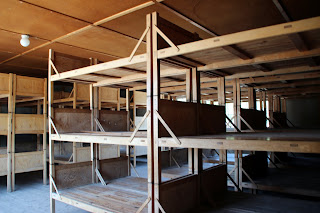Dachau Concentration Camp was the first thing we did, and
probably the most depressing way to start your day. Knowing that I would be
walking in the place where thousands died, and more had suffered, was not a
good feeling. Dachau was the first concentration camp to open during the
Holocaust, and was the training grounds and model for other concentration camps
that opened later, such as Auschwitz. The camp originally houses political
people and prisoners of war, but later took in others as well. Learning about
the Holocaust is one thing, but actually being in a concentration camp, where
so many people died, is so much different. I don’t think I said much of
anything as I walked through, and I can’t imagine what it must have been like
to really be there, not just visiting years later.
(May the example of those who were exterminated here between 1933-1945 because they resisted nazism help to unite the living for the defense of peace and freedom and in respect for their fellow man)
These are the barracks that the ‘inmates’ stayed in. These
were originally built to house 150-200 but towards the end were housing 2000.
Each contained a living and sleeping quarter, a toilet and a washroom, followed
by another sleeping quarter. There were 36 in total in two rows covering the
length of the camp.
The first crematorium for the camp was built in 1940, and
the mortality rate heavily increased. During the three years it was open 11,000
people were cremated there. The Large crematorium built around 1942 or 1943
served as both a killing facility and removal of the dead.
The gas chamber, which was attached to the new crematorium
was never used for mass killings, but were used for small groups or
individuals. In 20 minutes the poison gas could kill a room of 150 people. The
gas chambers were disguised as showers, complete with shower heads so that
people would go into them, they were forced to take their clothes off and enter
the room and locked inside. Afterwards their clothes were taken to the
disinfecting chambers, were they were gassed as well.
The last room attached to the building was the Incinerator
room, which had four huge furnaces in it as well, which could cremate 3 or 4
bodies at once; they also used this room for torture as well. Many hangings
went on here; the victims would be hung directly in front of the burning ovens.
One thing that did surprise me about the camp was that they
had churches within the grounds, although Jews were not permitted inside.
The fence surrounding the camp was to make escape
impossible, there were guard towers located along the fence, and if you got to
close you would be shot at, and most of the time killed. If you happened to get
farther the fence would electrocute and kill you, many people committed suicide
this way.
Also in Munich is the BMW Welt by Coop Himmelblau. The
building is amazing, it had a reflective mirrored surface along the outside, a
twisted cone that you can go up into, a sky bridge leading to the BMW museum,
and the store in the very middle where you can buy your car, and literally
drive around the ramp and out the building. As cool as this all sounds we
probably picked the worst day to visit. There was an event going on in the
cone, the museum was closed, and there was lots of construction going on in the
inside so some of the exhibits were closed. We still got to see some cool cars,
and we saw a motorcycle stunt show, and some of us got to ride in the mini car.
We also got to see some people buy cars and drive around the ramp and out of
the building, although they didn’t turn on the flashing lights to announce a
car like they had apparently done in the past.
Right across the street from the building is the past
Olympic Village by Frei Otto and Gunter Behnisch. It was pretty cool. The roof
was extremely interesting the way it folded, bent, and met the ground in
places.
The Last stop of the day was the Herz-Jesu Kirche by ASW
architects. This was the church I was most excited about seeing in person. The
building consists of two boxes set inside one another. The inside box is wood
and the outside box in glass, which goes from transparent to translucent. Each
pane of glass has a series of blue nails inscribed on them to symbolize the
nails of Jesus, and the cover the outside of the church, switching between blue
nails on glass, and white nails on blue glass. When the church is actually open
the entire front opens and it seems like the boxes are sliding within each
other.
































No comments:
Post a Comment